Exhibition labels
1 & 3: Coconut cups with silver-gilt mounts
Coconuts – or ‘nuts of India’ as they were called before 1600 – are the fruit of the coconut palm, Cocos nucifera. By 1400 these trees were growing in India, from where their expensive and highly desirable nuts were imported...
2: Matthew Parker’s standing salt and cover
Salt-cellars came in all shapes and sizes, and wealthy individuals and establishments often owned several large examples in silver. Cylinder salts like this one were the height of fashion on English tables from c.1550, and remained popular for the next...
4 & 5: Matthew Parker’s two-handled posset cups and cover
These two ‘ox-eye drinking pots’ with fashionable dolphin-shaped handles are amongst the earliest posset cups known to survive. Posset was a comforting, spicy beverage made from hot cream frothed with egg, alcohol, and sugar. The narrow top was supposed to...
6: Matthew Parker’s tankard with hinged domed cover
Holding two-thirds of an English pint, this ‘gylt pott’ was given by Parker to Caius on New Year’s Day 1572, the same day he gave an identical one to Trinity Hall, and a slightly more elaborate one (made in 1571)...
7: Matthew Parker’s great standing cup and cover with ‘man-and-staff’ finial
Parker’s great standing cup is the second grandest in Cambridge (after the Vice- Chancellor’s Cup of 1592) and one of the most significant examples of an English standing cup of its date anywhere. It is a triumph of technical virtuosity...
8 & 9: Matthew Parker’s rosewater basin and ewer with hinged cover
This spectacular rosewater basin and ewer are late Gothic in style, dating from the reign of Henry VIII (1509 – 47). They are believed to be the earliest ewer and basin of this sort to survive anywhere in the world,...
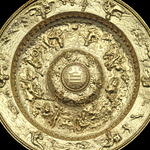
17: Basin with The Triumph of Neptune and The Battle between Marine Centaurs
This large silver basin is a masterpiece of the silversmith’s art using many different techniques. It has been embossed, chased, and engraved with marine imagery taken from two famous engravings by Jacques Androuet du Cerceau the Elder (c.1512– 86). One...
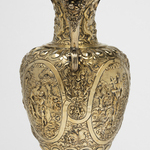
18: Ewer with personification of the virtues and fruit
This ewer is decorated with four oval medallions containing female personifications of Faith, Hope, and Charity (the three Theological Virtues) and Fortitude (one of the four Cardinal Virtues). They were presumably included as moral exemplars to diners and intended to...
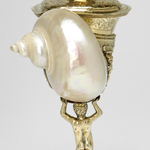
19: Nautilus shell standing cup with Chinese scenes and Neptune riding a dolphin
This fantastical nautilus shell cup is a truly global product. It was constructed in Elizabethan London, likely by an Antwerp silversmith, using a south-east Asian shell, engraved in China, mounted in precious silver- gilt fittings. Its stem and foot are...
20: Standing salt and cover with warrior finial
Evaporated from sea water, carved from salt mountains, and mined from salt caves, salt has been used for millennia in cooking and to preserve fresh food. Its sale was regulated by the state to ensure supply and fair prices. Fortunes...
21: Hexagonal salt with circular depressions at top and bottom
This salt’s small size and limited capacity may mean that it was for a lone diner. However, it more likely reflects the fact that salt was consumed in small quantities. Many salts were designed to prompt conversation or cause amusement....
22: Turbo shell
Turbo shell standing cup and cover with a boy standing on a turtle Turbo shells come from large sea snails living in warm tropical waters, often near coral, and were in great demand by European collectors. They were individually harvested...
23: Oval dish with The Wedding of Psyche and Cupid after Raphael
The upper surface of this splendid Limoges dish was decorated with the pagan story of Psyche and Cupid’s wedding feast, based on Raphael’s celebrated 1517 fresco in the Villa Farnesina, Rome. Courteys has also lavishly decorated its underside with Jupiter,...
24: Libro de dissegni per far vasella di argento et oro per servitio della credenza e tavola
Libro de dissegni per far vasella di argento et oro per servitio della credenza e tavola These drawings are early copies of original designs by Giulio Romano, an architect and designer who worked for the Gonzaga court in Mantua, northern...
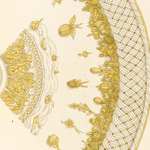
25: Still life with fruit and calf’s tongue
Still life with fruit and calf’s tongue Valued for its delicate flavour and texture, a cooked and trimmed calf’s tongue takes pride of place in this still life that celebrates abundance. The figs, lemons, grapes, and pomegranate were expensive luxuries...
42: Tiles depicting buckwheat milling
Buckwheat was the cereal of the poor, and accounted for a fifth of all grain consumed in Holland by the end of the eighteenth century. This tile picture shows the typical interior of a rosmolen (horse-powered rotary mill) and the...
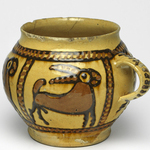
43: One-handled honey pot
One-handled honey pot with three hounds chasing a hare. This late seventeenth-century honey pot would, originally, have had a ceramic lid to keep dust and insects out. It is a rare survival as they were easily broken, which explains why...
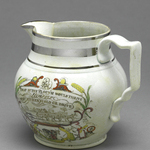
44: Hannah Robinson’s jug
This small, highly decorated jug, likely for milk or ale, is inscribed ‘Hannah Robinson 1812’. When Dr Glaisher purchased it in 1909, he was told that Hannah had been given this jug when she married Gabriel Store, in 1812, probably...
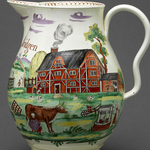
45: Harvest jug
This jug’s inscription states: ‘Now I am come for to supply your workmen when in harvist dry when they do labour hard and sweat good drink is better far than meat’. Beer was drunk as quick liquid energy during bouts...
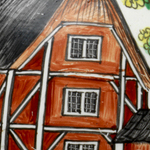
46: John Bridgen’s jug with a farmyard scene
Demand for dairy produce increased in eighteenth-century Britain. Ensuring that dairy herds had food during the Winter was critical, so haymaking became an important annual event. This explains its inclusion on John Bridgen’s milk jug, even if by 1780, cows...
47: Butter dish, cover with cow-knob, and stand, all with trellis pattern
By the mid-eighteenth century, Cambridge was a hub through which a staggering 90,000 firkins (1 firkin = 56 lbs, or 25 kgs) of butter were dispatched annually to London from Norfolk, south Lincolnshire, and the Isle of Ely, salted and...
48: Tureen and cover
Tureen and cover in the form of a rabbit Ceramic tableware in the form of edible animals, vegetables, and fruit was made for display and use. When placed on the dining table, it was intended to deceive, surprise, and amuse...
49: Tureen and cover formed as a hen with chicks, and stand formed as leaves and flowers
Many people kept domesticated poultry – chickens, geese, and ducks – for their eggs, meat, and feathers, for personal use or for sale. In Humoral theory, chickens were classified as hot and dry, which made them suitable for those with...
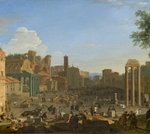
54: The Campo Vaccino, Rome
Cities were filled with the smells, noises, and movements of animals, as they lived in close proximity to humans. Live cattle and sheep were driven ‘on the hoof’ from the countryside into the city for sale. In van Swanevelt’s view...

26: Allegory on The Golden Age and The Fall of Man
This idealised vision of men, women, and animals living harmoniously together derives from Ovid’s Metamorphoses, an ancient Roman source for mythological stories in European art. In the Golden Age, Ovid told of the blissful existence of the first humans on...
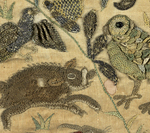
27: Embroidered panel depicting Arcadia
The sound of the shepherd’s pipes and the bleats of his sheep can almost be heard alongside the clucking of the hens around his female companion, in this seventeenth- century embroidered panel. The smells of roses, cornflowers, cowslips, thistles, and...

28: Beadwork panel depicting Paradise, The Temptation of Adam and Eve, Cain killing Abel, and The Sacrifice of Isaac
There are complex theological messages related to food from Genesis (the Bible’s first book) in this colourful beadwork panel. On the left, the presence of a unicorn and a mermaid suggests that this is paradise or the Garden of Eden....
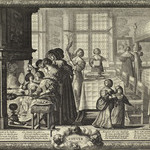
29: The Four Seasons
The Four Seasons and Maarten de Vos’ drawings In the second half of the sixteenth century, many artists made ‘profane allegories’ or ‘instructive series’ of prints. This set of drawings of The Four Seasons was used to create a set...

29: Spring with Venus and Cupid
Spring with Venus and Cupid, from The Four Seasons Shown semi-naked with spring flowers and doves, Venus, goddess of love, personifies Spring. She gently restrains her son, Cupid, eager to let loose his love arrows and cause havoc. To the...
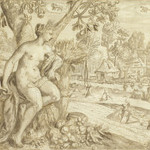
30: Summer with Ceres
Summer with Ceres, from The Four Seasons Our 2019-12-04- ‘cereal’ derives from Ceres, goddess of agriculture, who personifies Summer. She rests on a wheat sheaf under the shade of a fruiting tree, a sickle in hand, while keeping a careful...





